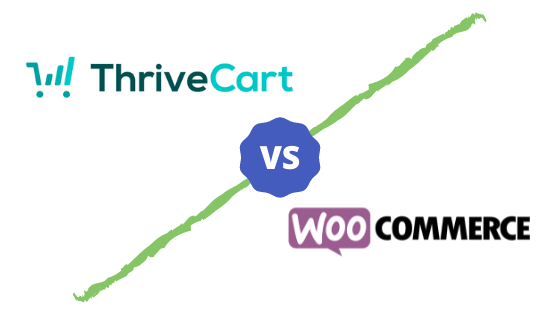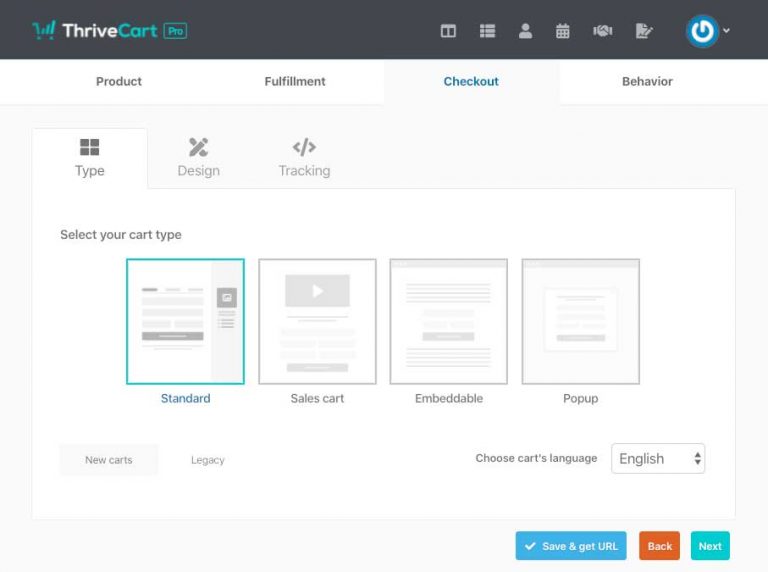ThriveCart vs WooCommerce 2025 Comparison

Have you been looking for a platform that provides the best-in-class checkout experience for your customers? Your search is sure to have brought up names such as Thrivecart and WooCommerce, and now, you’re wondering which of the two to pick.
Well, your search for the right platform ends here as we compare Thrivecart and WooCommerce on a host of factors such as ease of creating checkout pages, integrations, customer support, reporting and analytics, and more to give you the winner in each category.
Before we jump into this comprehensive comparison, note that Thrivecart is offering a lifetime membership for a one-time payment of $495. While WooCommerce is free to use, you have a 30-day free trial for its paid extensions.
What Is ThriveCart?
Thrivecart is a checkout platform that’s designed to boost your conversion rates and comes with a host of features that make it easy to sell your products and services online.
This hosted service integrates well with many leading tools to extend its functionality and to provide end-to-end digital marketing capabilities.
What Is Woocommerce?
WooCommerce is a tool used for building a complete eCommerce business from scratch. However, it is hosted on the WordPress platform, so works well only if you have a WordPress site.
Like Thrivecart, WooCommerce also integrates with a ton of tools, but only within the WordPress ecosystem.
Who Is It For?
Thrivecart is the choice for businesses, solopreneurs, and digital marketers who need a shopping cart and landing page that works right out of the box. Its sales funnels support a wide range of products and services including membership sites.
WooCommerce, on the other hand, is a good choice for those looking to build an eCommerce business to sell different products and manage their inventory levels automatically. However, your site must be hosted on WordPress.
Product Checkout Pages
Thrivecart has the features needed to create conversion-optimized checkout pages that can boost your sales. These pages are designed to be appealing to your customers and at the same time, easy to navigate, so your visitors can easily find what they want.
The design editor is intuitive and doesn’t need any coding skills or prior technical experience to create checkout pages.
Its built-in sales funnels also help in creating checkout pages designed to boost sales.

It also has a robust affiliate management center where you can bring on affiliates to sell more products for you and manage their performance and commissions through this platform.
As for WooCommerce, it offers a wide variety of themes and templates for your checkout pages, so they can be designed just the way you want. Further, it’s easy to add product images and other design elements to make your checkout page stand out.
However, some amount of coding or technical experience is required to use WooCommerce.

Which of the two is better? Thrivecart is a better choice because it’s easy to create conversion-optimized checkout pages and further, you can tap into your affiliate network easily.
Can These Platforms Sell Both Digital and Physical Products?
Thrivecart’s features help you to sell any physical or digital product including membership sites, courses, and more. You can even embed Thrivecart in your existing website to create a streamlined checkout experience for your users.

WooCommerce, on the other hand, is more suited for selling physical products online, as it gives you the flexibility to add any number of products, their images, and more.
Also, it comes with advanced product sorting and filtering capabilities to make it easy for your customers to find what they want. They can sort your products through many filters such as price, size, and more. These listings help with search engine rankings as well, so your site can benefit from organic visits as well.

The built-in inventory management system displays only the available products to your visitors.
However, WooCommerce is not conducive to sell digital products like online courses and membership sites.
The winner depends on what you’re selling. If you’re selling physical products through a WordPress site, WooCommerce is a good choice, but if you’re selling digital products, go with Thrivecart.
Ability to Convert Prospects
The ability to convert prospects is one of the key objectives of an eCommerce site, and Thrivecart offers many features to support it.
Its A/B testing feature helps you to test many designs before zeroing in on the template that has the highest conversion rate. This split test is comprehensive and measures your pages, steps, offers, price, and even the header to ensure that every aspect is conversion optimized.

Further, you can easily customize the checkout pages to make them attractive for your customers, so they linger long enough on it, to buy a product.
Thrivecart also integrates with email software such as MailChimp and Aweber to send follow-up emails. It can also send reminders about items that are in the cart to boost the chances for a sale.
WooCommerce is not as comprehensive as Thrivecart, but the advantage is you can add plug-ins and elements to create pages exactly the way you want. Still, there are no specific features like split testing to boost conversion rates. However, you can use content marketing through its built-in blogging feature to promote your products.
Given these limitations, Thrivecart is the clear winner in this category.
Product Payment Models
Research shows that having many product payment models give buyers the feeling that they are getting more value for their money, so this feature must be a key part of your decisions.
For example, let’s say a person buys a printer. When you offer a bundle of papers or an ink cartridge at a discounted price, the customer is likely to buy them too. Overall, it boosts your sales without a lot of extra effort.
Thrivecart makes it easy to add upsells, cross-sells, and order bumps, so when customers are ready to buy a product, they see a related product and tend to buy that too, thereby increasing your revenue.
To give you a brief overview, an upsell and an order bump advertise a higher value offer. While an upsell is displayed as a pop-up, an order bump displays the same on the checkout page. Cross-sells, on the other hand, display complimentary products that are offered along with the product that’s purchased.
It’s easy to add coupons and discounts as well, and they can be placed at strategic locations to ensure that your customers don’t miss them at all. Such offers can enhance your conversion rates as well.

Such streamlined product payment models are not available out-of-the-box with WooCommerce, and you have to spend extra time and money, and possibly even hire developers, to build this functionality for you.
From the above comparison, Thrivecart is the only choice when you want to leverage multiple payment models.
Reporting and Analytics Feature
Thrivecart has a detailed live stats section where you can track all analytics related to your sale and promotions. When you combine this with A/B testing, you can identify the conversion-optimized parts of the checkout page and which areas need to be improved to boost sales.
You can also integrate with Google Analytics to get more detailed statistics.
While WooCommerce by itself doesn’t have advanced reporting and analytics, the fact that it can be integrated easily with other plug-ins in the WordPress ecosystem enhances its ability to provide the necessary analytics you need.

Out of the two, Thrivecart is better again because it has reporting and analytics features natively and also integrates with Google Analytics to give the insights you want.
How Well Do They Integrate With Other Tools?
Both platforms integrate well with other tools, but their integration is not similar.
Thrivecart integrates with many CRM, email marketing, and other tools. You can even embed Thrivecart in your existing website’s checkout page.

WooCommerce, on the other hand, uses the REST API to integrate with other tools. However, it integrates only with tools that also have REST APIs such as the ones in the WordPress ecosystem and a few others like Google Analytics.
Also, you may need the help of technical experts and developers for pulling off this integration.
Overall, WooCommerce offers a greater variety of integrations, provided you can afford to hire a developer to integrate them for you. Thrivecart’s integrations are limited when compared with the WordPress ecosystem, but it’s easy to integrate and requires no external help.
In this sense, the winner depends on your needs.
Customer Support and Community
Thrivecart offers customer support through emails. You can also submit a ticket through the form on their site and you’re highly likely to get a response within 24 hours. Further, the documentation is extensive and you’re sure to find answers to most questions or problems you have with Thrivecart.
They also have a Facebook group where other users can provide answers to your questions.
As for WooCommerce, it has an extensive community as it taps into the larger WordPress followers. You can get answers to most concerns through this community.
As for the winner, it’s Thrivecart if you prefer one-on-one communication with the support team. On the other hand, if you prefer community support and enjoy being a part of it, WooCommerce is your choice.
Ease of Use
On the face of it, both platforms are intuitive and easy to navigate. You can do most basic things like creating a page and setting up payment options easily.
However, the key difference between the two is in integrations. While Thrivecart is easy to integrate, WooCommerce will require technical assistance. The same is true for implementing many advanced features as well such as order bumps and cross-sells. From this perspective, Thrivecart is easier to use and requires no coding skills at all.
What Tools Are Available On Thrivecart and Not On WooCommerce?
The tools available on Thrivecart, but not on WooCommerce are:
- Sales tax computation
- Funnel Builder
- Built-in affiliate management system
- Multiple product payment models like upsells, cross-sells, discounts, and more
- Customer support
- A/B testing
What Tools Are Available On WooCommerce and Not On Thrivecart?
The tools available in WooCommerce, but not on Thrivecart are:
- WordPress ecosystem
- A vibrant community
- Built-in blogging
- Extensive collection of themes
- Support for multiple products
- Automatic inventory management
Thus, these are how the two platforms stack up against each other.
Thrivecart Vs Woocommerce Pricing
Moving on to pricing, Thrivecart pricing is offering a limited-time offer of $495 for a lifetime account, where you have access to all its features and services.
WooCommerce’s pricing is a bit complex. As a WordPress plugin, it’s open-source and free to install. However, it works well only on WordPress sites, which means you must pay a minimum of $12 a year for the WordPress domain.
There are additional costs for web hosting and you may have to pay for specific themes and features. While the cost depends on how many advanced features and themes you use, there’s no doubt that the costs can quickly increase with WooCommerce.
Also, it’s recurring and you’ll have to pay monthly/yearly, depending on your preference.
Conclusion
So, here comes the big question. Which tool is right for your business?
Choose Thrivecart if you,
- Want to offer order bumps, one-click upsells, cross-sells, and other offers to boost your sales
- Are looking to create conversion-optimized checkout pages with the help of an intuitive editor.
- Have no prior coding skills
- Are on a budget
- Need automatic sales tax computation
- Want to embed a shopping cart/checkout page on an existing website
- Require out-of-the-box reporting and monitoring capabilities
- Need integration with popular tools like Hubspot, MailChimp, and more.
- Want to sell physical and digital products like membership sites
- Need robust affiliate management capabilities to tap into your affiliate network and boost sales
Choose WooCommerce if you,
- Have a WordPress site and want to add checkout capabilities to it
- Want to leverage the WordPress ecosystem
- Can access the skills of developers
- Want to sell multiple products with automatic inventory management
- Are looking to be a part of a large community
- Need a built-in blog that can talk about your products and their benefits
Are selling multiple physical products and want to extensively tap into content marketing to promote these products.
This post may contain affiliate links and we may earn commissions. Learn more in our disclosure.

